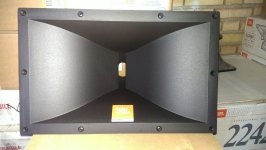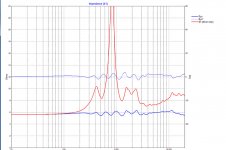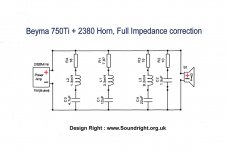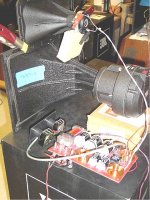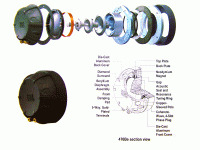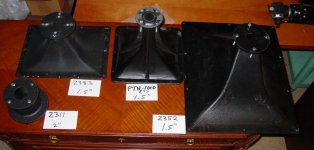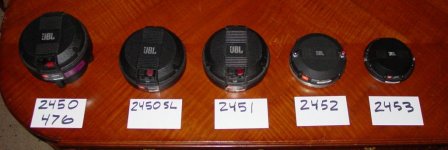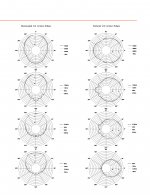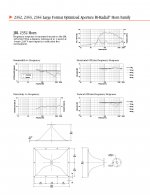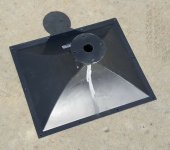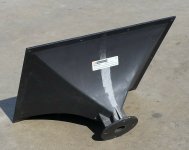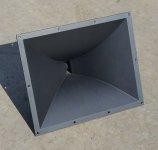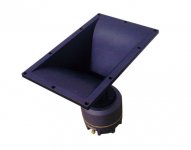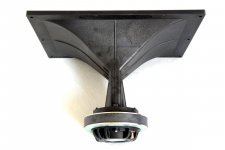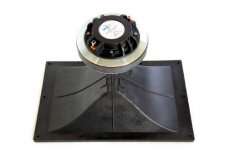Cheers for that. I bought a pair of the horns and those drivers last week.
I'll send some guff your way if they quack.

Does that mean you are playing with horns now?
I have no doubt the 2380 can quack like Donald Duck at higher levels. I actually designed the Basement Blasters using B&C ME75s (which is a very similar flare horn made from aluminum which I prefer over plastic (see damping methods I used below wihch I believe reduced coloration more than a plastic flare would be likely to achieve) which B&C had discontinued but now apparently brought back.
I'm using JBL 2445Js with titanium diaphragms with the ME75s, so clearly my objective here is not ultimate sound quality but high SPL 'best quality' reinforcement instead, so I also wanted to add some diffraction suppression. Firstly, I added damping material at the horizontal sides of the horn mouth that was built into the 3/4" baffle plate and added a quarter circle taper at the top and bottom of the baffle plate horn opening. I also covered the entire back side of the horn flare with a non-hardening mortite material. And another thing I did was to add about a 1" wide strip of mortite material immediately beyond the internal diffraction fold tapered to give a smoother transition there. This last may have done a little damage to the horizontal dispersion at high frequencies, but it definitely tamed down the 'honk' so it's more like a broader band but much lower level 'cool sounding' HF coloration on axis at high SPLs.
I also wanted to mention that I used the 2445 instead of a 2446 because I had seen frequency response charts of both into an ME60, and the 2446, while having a slightly boosted response between 10 and 14 khz, dropped off like a rock above 17 Khz, while the 2445 had response that for my purposes at 101db/w/m let me tune it basically flat out to 22 khz.
Btw, passive xovers used throughout - in the bass, gain was achieved in the bottom octave that is impossible to do with active xovers and since I can handle designing passive filters including partial notches - I prefer not adding all the distortions most active eq schemes impose.
I'm using JBL 2445Js with titanium diaphragms with the ME75s, so clearly my objective here is not ultimate sound quality but high SPL 'best quality' reinforcement instead, so I also wanted to add some diffraction suppression. Firstly, I added damping material at the horizontal sides of the horn mouth that was built into the 3/4" baffle plate and added a quarter circle taper at the top and bottom of the baffle plate horn opening. I also covered the entire back side of the horn flare with a non-hardening mortite material. And another thing I did was to add about a 1" wide strip of mortite material immediately beyond the internal diffraction fold tapered to give a smoother transition there. This last may have done a little damage to the horizontal dispersion at high frequencies, but it definitely tamed down the 'honk' so it's more like a broader band but much lower level 'cool sounding' HF coloration on axis at high SPLs.
I also wanted to mention that I used the 2445 instead of a 2446 because I had seen frequency response charts of both into an ME60, and the 2446, while having a slightly boosted response between 10 and 14 khz, dropped off like a rock above 17 Khz, while the 2445 had response that for my purposes at 101db/w/m let me tune it basically flat out to 22 khz.
Btw, passive xovers used throughout - in the bass, gain was achieved in the bottom octave that is impossible to do with active xovers and since I can handle designing passive filters including partial notches - I prefer not adding all the distortions most active eq schemes impose.
Last edited:
"Passive xovers used throughout" "I prefer not adding all the distortions most active eq schemes impose"
Sorry, no disrespect intended but this is utter nonsense! What distortions active schemes impose? Doesn't even get close to the plethora of sins that passive networks are responsible for..where do you get this stuff from!
As these comments are based in no fact whatsoever I can only steer you towards Siegfried Linkwitz's site and Elliott Sound Systems to name but two who have a few things to say on this issue. I should not be staggered that anyone can still believe that full damping from a power amplifier is a bad thing and that any passive can compete with current active designs, particularly dsp, with superbly accurate filter responses, .0007% typical distortion and 115+db dynamic range..never mind the ability to time align.
Sorry but this just beggars belief. I was using analogue active on sound rigs in the 70's because even then they were superior to passive.
We also steered off the subject of the original post which by the way was not comparing the 2380 with smaller horns or 60 x 40 horns. Actually it wasn't comparing them with any horns, just plots of themselves!!
And again, yes 10% distortion but at 125db (10 watts in) and 2nd Order, which adds even harmonics which are not usually audible at these levels (because your ears are distorting) as they just make the sound a bit warmer and richer. True, the slot is responsible for distortions at high input but no horn is perfect and there are also trade off with all of them, many of which I have, including 15 cell multicells, which actually this horn was almost designed to replace. If you want wide dispersion with a low cut off and a flat even response in a compact horn then you must trade something..the slot is there to achieve these design goals?
But, as per the original post, I am not interested in the performance of these horns for live music. I specifically stated these were short throw wide dispersion horns for studio or domestic purpose and if the distortion really freaks one out at a watt or two max(still 110/113dB at 1 metre) then cross it over, (actively of course and time aligned to account for the large distance between the voice coils...) to a tweeter at 6-8kH. The Bob Crites T35 does it well widening out the dispersion again at HF and can be eq'd to provide an extended flat response.
I think you do have a good point about adding damping material to the horn flares and this certainly makes sense. Again these horns, like all others, are built to a price (quite a lot for the JBL..much less for the copies!) and usually a combination of fibreglass and plastic...here the knuckle test can be useful!
Sorry, no disrespect intended but this is utter nonsense! What distortions active schemes impose? Doesn't even get close to the plethora of sins that passive networks are responsible for..where do you get this stuff from!
As these comments are based in no fact whatsoever I can only steer you towards Siegfried Linkwitz's site and Elliott Sound Systems to name but two who have a few things to say on this issue. I should not be staggered that anyone can still believe that full damping from a power amplifier is a bad thing and that any passive can compete with current active designs, particularly dsp, with superbly accurate filter responses, .0007% typical distortion and 115+db dynamic range..never mind the ability to time align.
Sorry but this just beggars belief. I was using analogue active on sound rigs in the 70's because even then they were superior to passive.
We also steered off the subject of the original post which by the way was not comparing the 2380 with smaller horns or 60 x 40 horns. Actually it wasn't comparing them with any horns, just plots of themselves!!
And again, yes 10% distortion but at 125db (10 watts in) and 2nd Order, which adds even harmonics which are not usually audible at these levels (because your ears are distorting) as they just make the sound a bit warmer and richer. True, the slot is responsible for distortions at high input but no horn is perfect and there are also trade off with all of them, many of which I have, including 15 cell multicells, which actually this horn was almost designed to replace. If you want wide dispersion with a low cut off and a flat even response in a compact horn then you must trade something..the slot is there to achieve these design goals?
But, as per the original post, I am not interested in the performance of these horns for live music. I specifically stated these were short throw wide dispersion horns for studio or domestic purpose and if the distortion really freaks one out at a watt or two max(still 110/113dB at 1 metre) then cross it over, (actively of course and time aligned to account for the large distance between the voice coils...) to a tweeter at 6-8kH. The Bob Crites T35 does it well widening out the dispersion again at HF and can be eq'd to provide an extended flat response.
I think you do have a good point about adding damping material to the horn flares and this certainly makes sense. Again these horns, like all others, are built to a price (quite a lot for the JBL..much less for the copies!) and usually a combination of fibreglass and plastic...here the knuckle test can be useful!
Actually, you're quite wrong regarding passive xovers. Component for component, every part I use in my passive xovers: resistors, capacitors and inductors, is far superior in intrinsic quality to every part used in the analog domain in whatever op amp ridden quantization distortion RF noise generating jittering sand box you may prefer. The idea that all drivers must sound 'superior' when driven from a zero ohm impedance is essentially a myth.
I'm an EE with an analog, embedded uP and DSP background, and I am well familiar with the many "garbage in" conduits that exist in virtually all commercial products. Plus, most importantly, they sound inferior to a competent passive xover in many musically important aspects.
I'm an EE with an analog, embedded uP and DSP background, and I am well familiar with the many "garbage in" conduits that exist in virtually all commercial products. Plus, most importantly, they sound inferior to a competent passive xover in many musically important aspects.
Last edited:
...But, as per the original post, I am not interested in the performance of these horns for live music. I specifically stated these were short throw wide dispersion horns for studio or domestic purpose and if the distortion really freaks one out at a watt or two max(still 110/113dB at 1 metre) then cross it over, (actively of course and time aligned to account for the large distance between the voice coils...) to a tweeter at 6-8kH. The Bob Crites T35 does it well widening out the dispersion again at HF and can be eq'd to provide an extended flat response.
Not a direct question for SoundRight, but a general comment and a question for folks on the thread as I am using the 2380a's for studio use.
My active 3-way Bob Crites Cornsacla uses a P-Audio 2380 clone mated to a Selenium D405 2" (the old phenolic) covering the midrange from 500 Hz to 5 kHz. For 5 kHz on up, I use a BMS 4540ND mated to the QSC waveguide from Parts Express - really happy with the latter combo, both from a sound quality and constant directivity perspective.
I use digital XO, time alignment, DSP and have measured the frequency response of my right speaker at 6 locations covering a 6' x 2' grid area that represents the listening area:

Huge fan of constant directivity devices as musicians can sit in the listening area and get a consistent frequency response across the area with no-one complaining about narrowing coverage as frequency rises
However, when the system is cranked up, there does appear to be some level of midrange distress - don't know how to subjectively quantify it - "quack" - maybe... but does not sound like flat response. I have not yet tried to isolate this if the coloration is coming from horn, CD or both... I have tried a few REW sweeps at higher SPL's and does not show up as increased distortion or peakiness in frequency response. I may still try this with REW, but it appears to only show up with dynamic music material and not steady state measurements.
My question is, is there "technically" a better waveguide (preferably 90 x 40 pattern and constant directivity) than the 2380a? What I mean by "technically" better is that the QSC on the treble sounds exceptionally smooth and unstressed no matter what the SPL and has excellent off axis measurements. A replacement for the 2380a would cover 500 Hz to 5 kHz using a 2" compression driver. As the QSC waveguide does not fit the existing enclosures, I will be building a new set of cabs anyway.
Thanks for your insights.
Mitch
A quick test of 6 measurements with REW sweeping from 400 Hz to 6 kHz near field mic’d starting at 98 dB SPL and incrementing to 125 dB SPL (measured using an SPL meter where the measurement mic is) shows no anomalies in frequency response or impulse response.
Overlaying 5 of the responses show that the measured curves are virtually identical with corresponding THD’s of 0.312%, 0.512%, 0.909%, 1.63%, and 2.93% respectively.
Only overlaying the last (green) curve (126 dB SPL) do I see a slight frequency and impulse deviation and an increase of THD to 5.22%.
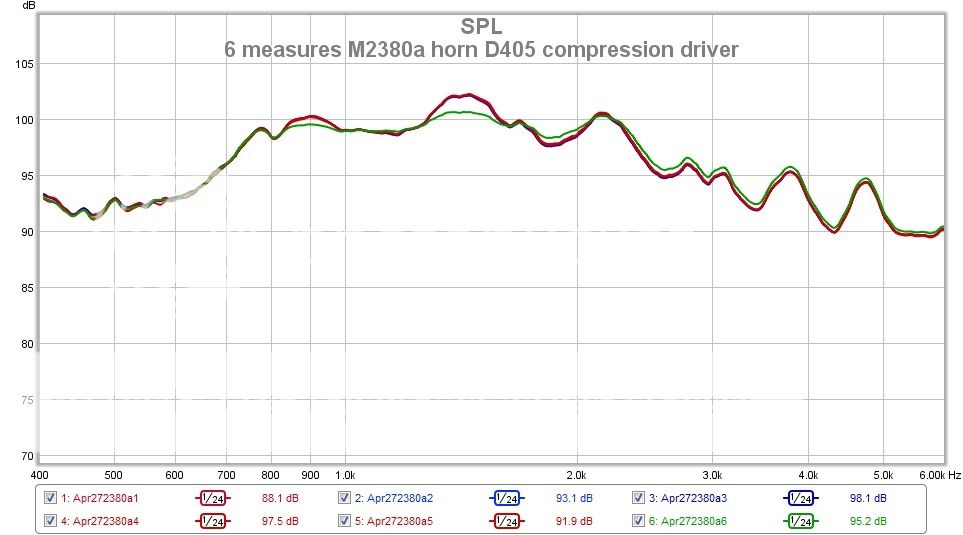

Given that I am using low wattage Class A amplifiers (Nelson Pass ACA) to drive the midrange, it is possible that I am pushing the limit of the amp at 126 dB SPL.
If I get a chance over the next couple of day’s I will hook up a more powerful amp and see if I get the same results…But so far no measured evidence of horn quack or honk or at least from the steady state measurements...
Overlaying 5 of the responses show that the measured curves are virtually identical with corresponding THD’s of 0.312%, 0.512%, 0.909%, 1.63%, and 2.93% respectively.
Only overlaying the last (green) curve (126 dB SPL) do I see a slight frequency and impulse deviation and an increase of THD to 5.22%.


Given that I am using low wattage Class A amplifiers (Nelson Pass ACA) to drive the midrange, it is possible that I am pushing the limit of the amp at 126 dB SPL.
If I get a chance over the next couple of day’s I will hook up a more powerful amp and see if I get the same results…But so far no measured evidence of horn quack or honk or at least from the steady state measurements...
More interesting...!
This thread is getting more interesting! Thank you for posting plots and data, much more useful than just "personal opinions"?
Anyway, noted just a couple of things, Mitchba's response plots do show the couple of humps in response as illustrated by JBL as well..as can be seen these occur at 1500 and around 2k2. I suggest it may be worth taking these out, particularly as you are using dsp to control the system. I suspect these would be quite audible.
126dB..wow! I can't get close that where I live!! Anyway, substantially low distortion figures as one might expect as the 2nd harmonic only really starts to rise above 8Khz or so? This is a tricky one, do you go for "one source" and use the 2380 all the way or add another horn which even with dsp and time alignment will produce vertical lobbing due to the distance between the centres...I guess one of those things you live with!
I also use the P Audio clone..this is a remarkable horn copy (sorry JBL) and available in the UK for around £25...one fifth of the price of the JBL!!
It occurred to me that the horn and driver combination will usually create complex impedance to the amplifier. Although there should be no difference in measured FR by using an impedance notch filter I have found in the past it certainly helps the "sound quality". Flat impedance ( and phase angle) will also benefit those who choose to use "esoteric" low powered single ended valve amps or even low powered transistor amps?
Although the horn cut off is indeed around 400Hz with recommend use from 500Hz this will usually fall right around the compression driver resonance for many drivers. It would be interesting to test them with the BMS coaxials with a resonance of 300Hz.
Another issue is of course the vertical directivity at this lower part of the frequency spectrum and the "old boys" would usually suggest you should use horns at twice their cut off..so 800Hz might be a good starting point?
Back to resonance circuits..the DAT's software has become an integral part of my test kit and thank you Xsim for your wonderful program! I ran an impedance plot of the Beyma 750Ti + 2380a and then derived a resonance circuit to flatten the impedance.
I am attaching the Impedance plot, original impedance in Red and flattened in Blue..and the circuit (yet to be tested!)
This thread is getting more interesting! Thank you for posting plots and data, much more useful than just "personal opinions"?
Anyway, noted just a couple of things, Mitchba's response plots do show the couple of humps in response as illustrated by JBL as well..as can be seen these occur at 1500 and around 2k2. I suggest it may be worth taking these out, particularly as you are using dsp to control the system. I suspect these would be quite audible.
126dB..wow! I can't get close that where I live!! Anyway, substantially low distortion figures as one might expect as the 2nd harmonic only really starts to rise above 8Khz or so? This is a tricky one, do you go for "one source" and use the 2380 all the way or add another horn which even with dsp and time alignment will produce vertical lobbing due to the distance between the centres...I guess one of those things you live with!
I also use the P Audio clone..this is a remarkable horn copy (sorry JBL) and available in the UK for around £25...one fifth of the price of the JBL!!
It occurred to me that the horn and driver combination will usually create complex impedance to the amplifier. Although there should be no difference in measured FR by using an impedance notch filter I have found in the past it certainly helps the "sound quality". Flat impedance ( and phase angle) will also benefit those who choose to use "esoteric" low powered single ended valve amps or even low powered transistor amps?
Although the horn cut off is indeed around 400Hz with recommend use from 500Hz this will usually fall right around the compression driver resonance for many drivers. It would be interesting to test them with the BMS coaxials with a resonance of 300Hz.
Another issue is of course the vertical directivity at this lower part of the frequency spectrum and the "old boys" would usually suggest you should use horns at twice their cut off..so 800Hz might be a good starting point?
Back to resonance circuits..the DAT's software has become an integral part of my test kit and thank you Xsim for your wonderful program! I ran an impedance plot of the Beyma 750Ti + 2380a and then derived a resonance circuit to flatten the impedance.
I am attaching the Impedance plot, original impedance in Red and flattened in Blue..and the circuit (yet to be tested!)
Attachments
...Anyway, noted just a couple of things, Mitchba's response plots do show the couple of humps in response as illustrated by JBL as well..as can be seen these occur at 1500 and around 2k2. I suggest it may be worth taking these out, particularly as you are using dsp to control the system. I suspect these would be quite audible.
126dB..wow! I can't get close that where I live!! Anyway, substantially low distortion figures as one might expect as the 2nd harmonic only really starts to rise above 8Khz or so? This is a tricky one, do you go for "one source" and use the 2380 all the way or add another horn which even with dsp and time alignment will produce vertical lobbing due to the distance between the centres...I guess one of those things you live with!
See post #26 and the frequency response of the overall system. The humps/bumps are smoothed out using DSP. The plots in post #28 are the raw response of the driver/horn combo without DSP so I can get the raw THD distortion figures without DSP messing that up. Here are a few distortion measurements at various SPL's. First at 98 dB SPL:
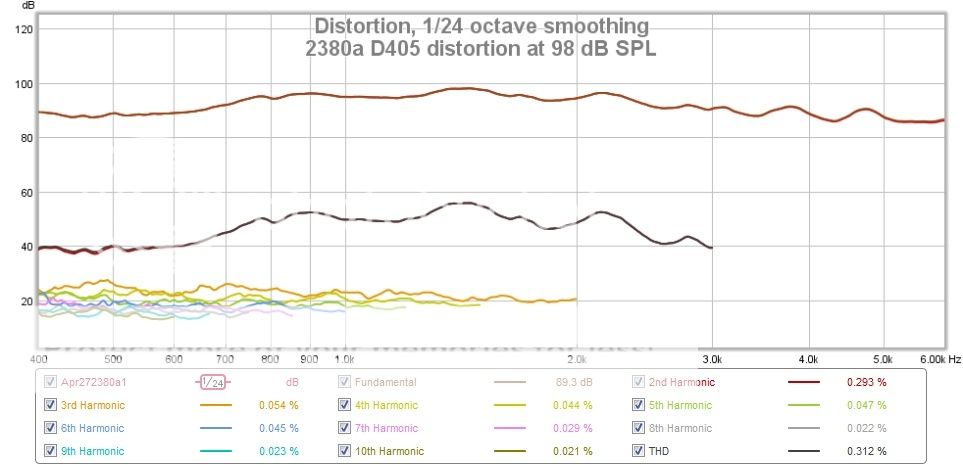
Skipping over the next 3 plots as they look similar. At a 120 dB SPL:

And at 126 dB SPL:
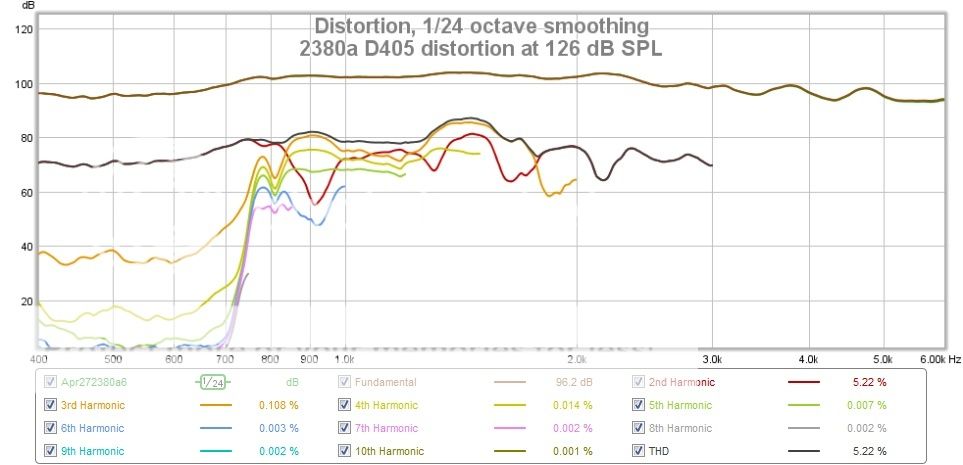
As mentioned in my previous post, this is likely the limits of the 6 watt power amp driving these, but need to verify with a higher power amp.
The Selenium D405 is an old school phenolic midrange driver with an operating range from 300 Hz to 7 kHz with a recommended XO of 500 Hz. An upper XO of 5 kHz may be pushing it for the D405. The BMS 4540ND/QSC HF waveguide combo XO can be moved down to a lower limit of 1200 Hz, so lots of room to play with.
Not sure what you mean by vertical lobing... moving the measurement mic around a 6' x 2' grid and above or below ear level at the listening position produces a smooth response like in post #26. From a listening perspective, I cannot hear two separate horns, it all sounds like point source.
My point in posting these measurements at various SPL's is to try and measure the so called quack or any issues with the diffraction slot. As you point out, lots of guff, but so far no objective measurements to substantiate any of these claims. Can anyone suggest a test that is both measurable and repeatable to expose claims of diffraction slot induced distortion?
have been looking patiently for minidsp config for my style A, but very few are going active with these for some reason.
the 6db rolloff on the D405 doesnt sit with me, i cant get anywhere close to your volume levels before the midrange breaks. then theres the problem with time delay, baffelstep on the woofer and some wild spl fluctuations from the drivers.
crites is an old school guy, if only he knew how much there is to gain here.
the 6db rolloff on the D405 doesnt sit with me, i cant get anywhere close to your volume levels before the midrange breaks. then theres the problem with time delay, baffelstep on the woofer and some wild spl fluctuations from the drivers.
crites is an old school guy, if only he knew how much there is to gain here.
Mitchba..excellent response plots and achieved over a wide window. I am baffled why people still use passive or even active analogue, particularly with horns with such different acoustic centres. I understand Mackie managed to create a delay with passive components for one/some (?) of their models but it is difficult to achieve and imperfect when compared to shifting the whole band with a fixed constant time delay. The only reason these days for not using dsp and multiple amplifiers should be cost. Many may claim they have achieved a flat response through the crossover, sometimes by reversing polarity..but this is a poor solution for the rest of the band!!
You have obviously achieved excellent summation between the horns and I have little doubt this is down to being able to use LR 24dB/octave crossovers with acoustic centre alignment and spacing. If the disbelievers could watch the spectrum analyser as the delay is dialled in and the response plot goes ruler flat through the crossover..and the massive response anomalies when the time delay is wrong perhaps they might be persuaded as to the veracity of using dsp and active.
When you think about it the four elements you need to control a multi way are level/gain, filter response, EQ and "time alignment". Analogue can manage the first three but only dsp can give you all four (and in such a neat package)!
The pro's know it, the studio's know it, the designers know it. It seems the only ones who refuse to accept it are those that enjoy spending their money on bits of cable, connectors, etc. Good luck to them, I am not one to spoil their "hobby"!!
It often crosses my mind that all of the top flight professional loudspeaker product is actually designed by those who understand the physics and ruthlessly test their product before going to market and you can be sure they fully understand the benefits of digital loudspeaker management!! So others can buy the £10, 000 8" full range driver or £1000/metre length of cable if it makes them happy but let's not pretend either make any difference in the real world of accurate sound reproduction?!
It was refreshing to read these latter posts (Mitchba +) and see the plots published.
Thank you for raising this issue out of the quagmire of personal and subjective worthless comment that we see so often on forums. I have absolutely no problem with those who seek knowledge, after all that is what the forum is for and we are all still learning about this complex and fascinating subject (even after 40 years!!) but I do have a massive aversion to BS!!!
You have obviously achieved excellent summation between the horns and I have little doubt this is down to being able to use LR 24dB/octave crossovers with acoustic centre alignment and spacing. If the disbelievers could watch the spectrum analyser as the delay is dialled in and the response plot goes ruler flat through the crossover..and the massive response anomalies when the time delay is wrong perhaps they might be persuaded as to the veracity of using dsp and active.
When you think about it the four elements you need to control a multi way are level/gain, filter response, EQ and "time alignment". Analogue can manage the first three but only dsp can give you all four (and in such a neat package)!
The pro's know it, the studio's know it, the designers know it. It seems the only ones who refuse to accept it are those that enjoy spending their money on bits of cable, connectors, etc. Good luck to them, I am not one to spoil their "hobby"!!
It often crosses my mind that all of the top flight professional loudspeaker product is actually designed by those who understand the physics and ruthlessly test their product before going to market and you can be sure they fully understand the benefits of digital loudspeaker management!! So others can buy the £10, 000 8" full range driver or £1000/metre length of cable if it makes them happy but let's not pretend either make any difference in the real world of accurate sound reproduction?!
It was refreshing to read these latter posts (Mitchba +) and see the plots published.
Thank you for raising this issue out of the quagmire of personal and subjective worthless comment that we see so often on forums. I have absolutely no problem with those who seek knowledge, after all that is what the forum is for and we are all still learning about this complex and fascinating subject (even after 40 years!!) but I do have a massive aversion to BS!!!
It seems that no one has mentioned the higher compression ratio of the old (skool) JBL 24 .. drivers as a possible cause of the duck noise at high SPL.
DJK (RIP) may not have been completely wrong in his assessment. Modern (pancake) drivers have a much lower compression ratio than the old heavyweights.
Even today, 2380 (clones) are used in highly regarded 2-way speaker systems. The Strauss MF2 (now MF2.2) and Tony Gee's Calpamos are 2 examples.
DJK (RIP) may not have been completely wrong in his assessment. Modern (pancake) drivers have a much lower compression ratio than the old heavyweights.
Even today, 2380 (clones) are used in highly regarded 2-way speaker systems. The Strauss MF2 (now MF2.2) and Tony Gee's Calpamos are 2 examples.
Last edited:
In addition, some Japanse "discovered" the throat of the 2380 is too short to properly match the deep exit section (with a low flare rate) of the old JBL drivers, which are basically WE594A/JBL375 derivatives. They fabricated a throat extension and I've posted the measurement results here.
Last edited:
JBL launched the Optimized Aperture Horns and Low Distortion Drivers to have:
1. The phasing plug coupled directly to the horn throat.
2. Lower distortion than earlier JBL and competitive combinations.
3. JBL's traditional 100 mm (4 in) titanium diaphragm integral to the design.
4. Excellent pattern control, extending down to the crossover range.
5. Consistent on-axis frequency response, model to model.
It's all in here:
1. The phasing plug coupled directly to the horn throat.
2. Lower distortion than earlier JBL and competitive combinations.
3. JBL's traditional 100 mm (4 in) titanium diaphragm integral to the design.
4. Excellent pattern control, extending down to the crossover range.
5. Consistent on-axis frequency response, model to model.
It's all in here:
Attachments
It would be interesting to see measurements of a vintage JBL driver, e.g. a 2445, versus one of the later models (2450 2450SL 2451 2452 2453) coupled to the 2380(A).
Don McRitchie in reference to the 475Nd:
"It's the same basic design as the 2450 as far as the motor and phase plug goes. The major differences are that the 476Be has no throat and uses a beryllium diaphragm with an Aquaplas coating. It shares the same "Coherent Wave" phase plug. It should be noted that the 475Nd from the M9500 uses an internal magnet structure and is thus shielded while the 2450/476Be both use an external structure. The lack of a throat means that an optimized flare rate can be chosen depending on the application. The throats on all of JBL's previous large format compression drivers used the 300hz flare rate from the original W.E. design. Since there is no need for that low a cross-over frequency for this compression driver, an optimized horn can be designed for any specific use."
Zilch:
"I recall concluding from the text description of 476Be that its design was distinguished in other ways, as well.
I can tell you that "Next Generation" 2452H-SL measures and sounds VERY different from 2450 with SL diaphragm"
Additional comments:
"Most likely due to the "throatless" design...better HF extension, less "honkey"? Reduced HF phase cancellations without the thoat."
subwoof (member of LasingHeritage):
"A bit of history ( as far as I can remember )...
The first Nd driver was a combination effort:
The internally shielded 475 as used in the flagship K2
And the 2450 as used in the last gen Concert series.
There is a good article on this but cannot find it right now.
Now of course many prototypes and other applications must of been used
but this is what was generally disclosed and marketed by JBL.
During this time the new generation horn design / size ( 1.5" ) was being introduced
to address the nagging throat cancellation / HF roll off that the 2" driver/horn combo's
had. Large touring systems had a hard time meeting response, distortion and of course,
WEIGHT requirements. So Nd drivers ( then the cones ) became the new norm.
Since the 1.5 horns are essentially throat-less, and the phase plug is right at the exit,
new computer modeling allowed superior performance from all area's.
And of course keeping JBL's " continued improvement " mantra meant that each newer
version becomes smaller, lighter and less costly to manufacture. Here are the drivers to date
( as of fall 2013 )
From left to right:
2450 2450SL 2451 2452 2453
Note the mounting hole pattern is different for the 2450SL and the 2451
- otherwise the motors are identical.
A group picture of a few 1.5" horns ( and a 2311 for ref ) shows the mounting flanges.
NOTE that since many of the newer PT horns have SMALL flanges the wider 2451
( and the sister ferrite 2447 ) cannot bolt to them HOWEVER the larger horns for the
most part can be re-drilled to accept the smaller pattern ( the 2383 is shown modded )."
Don McRitchie in reference to the 475Nd:
"It's the same basic design as the 2450 as far as the motor and phase plug goes. The major differences are that the 476Be has no throat and uses a beryllium diaphragm with an Aquaplas coating. It shares the same "Coherent Wave" phase plug. It should be noted that the 475Nd from the M9500 uses an internal magnet structure and is thus shielded while the 2450/476Be both use an external structure. The lack of a throat means that an optimized flare rate can be chosen depending on the application. The throats on all of JBL's previous large format compression drivers used the 300hz flare rate from the original W.E. design. Since there is no need for that low a cross-over frequency for this compression driver, an optimized horn can be designed for any specific use."
Zilch:
"I recall concluding from the text description of 476Be that its design was distinguished in other ways, as well.
I can tell you that "Next Generation" 2452H-SL measures and sounds VERY different from 2450 with SL diaphragm"
Additional comments:
"Most likely due to the "throatless" design...better HF extension, less "honkey"? Reduced HF phase cancellations without the thoat."
subwoof (member of LasingHeritage):
"A bit of history ( as far as I can remember )...
The first Nd driver was a combination effort:
The internally shielded 475 as used in the flagship K2
And the 2450 as used in the last gen Concert series.
There is a good article on this but cannot find it right now.
Now of course many prototypes and other applications must of been used
but this is what was generally disclosed and marketed by JBL.
During this time the new generation horn design / size ( 1.5" ) was being introduced
to address the nagging throat cancellation / HF roll off that the 2" driver/horn combo's
had. Large touring systems had a hard time meeting response, distortion and of course,
WEIGHT requirements. So Nd drivers ( then the cones ) became the new norm.
Since the 1.5 horns are essentially throat-less, and the phase plug is right at the exit,
new computer modeling allowed superior performance from all area's.
And of course keeping JBL's " continued improvement " mantra meant that each newer
version becomes smaller, lighter and less costly to manufacture. Here are the drivers to date
( as of fall 2013 )
From left to right:
2450 2450SL 2451 2452 2453
Note the mounting hole pattern is different for the 2450SL and the 2451
- otherwise the motors are identical.
A group picture of a few 1.5" horns ( and a 2311 for ref ) shows the mounting flanges.
NOTE that since many of the newer PT horns have SMALL flanges the wider 2451
( and the sister ferrite 2447 ) cannot bolt to them HOWEVER the larger horns for the
most part can be re-drilled to accept the smaller pattern ( the 2383 is shown modded )."
Attachments
Last edited:
2445, versus one of the later models (2450 2450SL 2451 2452 2453) coupled to the 2380(A).
You have 4 different phase plugs in that combination of drivers. Plus mostly 1.5" throats.
Rob
- Status
- This old topic is closed. If you want to reopen this topic, contact a moderator using the "Report Post" button.
- Home
- Loudspeakers
- Multi-Way
- JBL2380A, myth busting!
